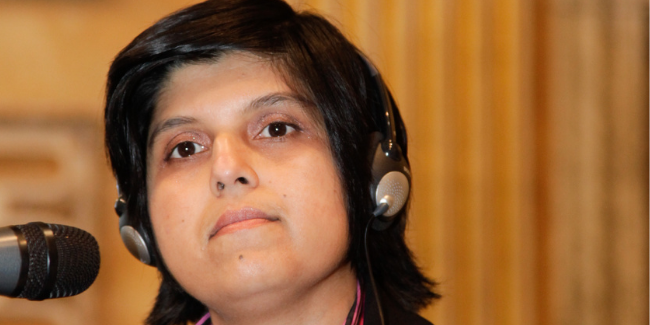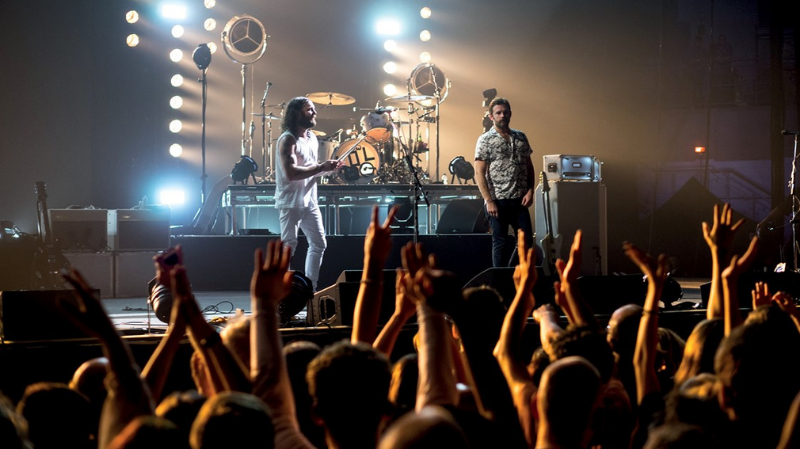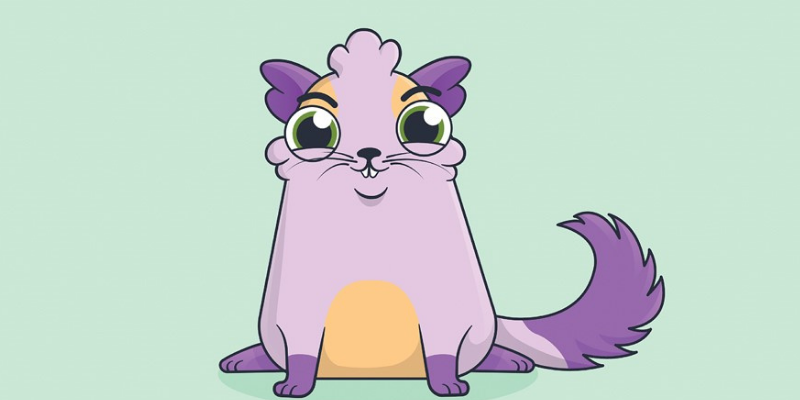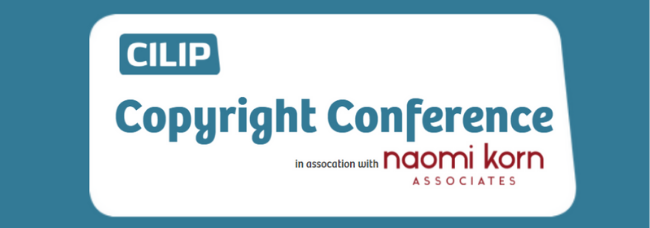
Dinusha Mendis, Professor of Intellectual Property and Innovation Law at Bournemouth University, explores copyright and IP developments caused by the digital revolution. Here she discusses NFTs, AI and 3D printing. Dinusha
is the opening keynote speaker at the CILIP and Naomi Korn Associates’ Copyright Conference on 18 May. Book your place at CILIP Copyright Conference.
Explaining what NFT stands for (Non-fungible token) what an NFT is (a digital file recorded on the blockchain) and what they are for (trading rare or limited edition items) still leaves most people perplexed about what an NFT really is,
and why anyone would want to own one. But thinking about why NFTs exist might help.
“In the past the reproduction of music and video games was to make them cheaper. That’s what the internet was about,” Dinusha Mendis says, “Lots for cheap, or free. Easy to copy, easy to access. But NFTs and the content which they are
linked to, are expensive and unique. It’s the whole opposite of what we have been dealing with all these years. In that sense it has changed the concept of ownership fundamentally.”
If Dinusha is right, NFTs wouldn’t be working if they didn’t cause ownership problems where there had never been ownership problems before.
It’s also a good example of the territory that Dinusha works in, as she explains: “The impact of new and emerging technologies relating to copyright and broadly on intellectual property – that’s always been my research interest. Way back,
I was interested in Second Life and then ebooks and so on. And more recently it’s been blockchain, NFTs and 3D Printing, and of course AI – which everyone is currently exploring.”
NFTs
“Everything has become digitised and everything can be reproduced. Whole aspects of rights and ownership have been undermined,” Dinusha says.
The first NFT was sold for $4 at a conference in New York – a digital video file recorded on the blockchain. And generally, that is what they still are, digital files that can be stored anywhere, but linked to the blockchain where all
transactions related to it are immutably recorded.
“So, what is different about NFTs?” Dinusha asks: “One of the fundamental things is this aspect of speculative investment. That you can buy an NFT, sometimes for ridiculous amounts of money, with the expectation that you can sell it again
for an even more ridiculous sum. But the only thing distinguishing the ‘original’ from identical copies is that the original is recorded on the blockchain which has the potential to authenticate originality and ownership.”
However, there are many variations of NFTs.
Some follow the original token plus file, but with extras. “I like the NFTs created by the band Kings of Leon – the first band to release an album as an NFT. Their terms and conditions say that you can’t copy or play the NFT for commercial
reasons, only for personal use. And while the album When you See Yourself will be sold on usual platforms, iTunes, Spotify, the NFT version (called NFT Your Self that sold for $50) comes in three forms that include digital
art and added real-world extras like front row seats to future concerts worldwide.”

Kings of Leon – the first band to release an album as an NFT. Photo: CC by 2.0 by Raph_PH
Other NFT content is more abstract and in some cases much more expensive. Dinusha uses the example of CryptoKitties. The game involves players buying, selling and breeding virtual cats – that’s the sole aim of the game. The old and new
Kitties are static images, but some have sold for more than $1m, even though with a right click you can get an exact copy. But the original is unique because it has the proof on the blockchain that it is the original.

Cryptokitty
Terms and conditions
In all these cases Dinusha says: “You have to ask yourself how much do you actually own, because ownership in a non-legal sense and a copyright sense are different and you won’t own the copyright unless the owner has assigned it to you.
Ownership has many facets to it. It is also worth noting that the company that runs CryptoKitties, Dapper Labs, was valued at $7.6b in September 2021 – so it’s part of a significant commercial operation.
“In the case of CryptoKitties, the NFT is a kitty, and the owners of CryptoKitties meet with other owners to breed new CryptoKitties and sell them. However, the “breeders” of CryptoKitties are bound by terms and conditions which state that they can’t earn more than $100,000 a year from their CryptoKitty. So, as in anything in life, there are terms and conditions. You can’t assume that because you’ve bought an NFT, that you can do whatever you want to
do with it.”
Are NFTs relevant to libraries?
“We are usually talking about art works, but papers and books and many other digital assets could be tokenised as NFTs too. One way I think this could be relevant to libraries (other than maybe issues about owning NFTs and lending them
out) is that libraries have very rare books, limited editions, that could be tokenised and sold. Why would the library do that? It may be that the library is willing to share ownership, subject to terms and conditions. In practice,
the rare book could be digitised and sold as an NFT but the actual book will stay in the library… and the money from the NFT sale could be invested back into development, or into other work in the library space.
“And there are already plenty of interesting developments in digital ownership models that may one day be relevant to libraries and information professionals. For example, the decentralised autonomous organisation (DAO), one of which nearly
raised enough money to buy one of 13 existing copies of the US constitution, as part of a scheme to prevent one institution holding it. “For libraries though, it might be that those who buy the rare book as an NFT can also claim ownership,
subject to the terms and conditions, however, the physical book would stay in the library – because it is impossible for so many people to have access to that one book – whilst on the other hand, it wouldn’t make sense for the library.
It would be similar to timesharing.”

No police
For decades rights owners have been trying to hold back the internet tide of free access to content. But NFTs are not part of this traditional defence of ownership. They originated from blockchain which is a decentralised system. “The
whole point is that it’s not like Google where there’s a centralised organisation, it’s a whole lot of people being responsible. Everything gets recorded on the blockchain and the blockchain is immutable, so even transactions that
are infringements – thefts and frauds taking place – they will always be there. But that’s all.
“If a platform is centralised it can be policed. You can get an injunction to stop people accessing the platform which blocks anything behind the platform. That’s not the case with NFTs. In some cases people have been defrauded – a recent
well known example was three valuable Bored Ape NFTs being stolen by hackers. Opensea and Rarible, the platforms where NFTs are traded, stepped in to save the day. But while one group of people said ‘that’s good, well done’ another
group was saying ‘what are you doing? We are meant to be decentralised’.”
AI and IP
Dinusha says: “There has been a lot written about it – about who is the owner etc. It’s a very important question. If you think about theories of international property, we’ve always had human creators, so you know who the rights holder
is, you know it follows the incentive theory and that the creator should be incentivised to create again. But if the work is created through AI or an algorithm, then do you reward the software creators or the people inputting the data?
Or someone else? “It’s very much a live issue. Last month the IPO was seeking views on this and other related questions and whether there should be a change in the law. Their position has been challenged in courts around the world,
the most recent was the Dabus case in the UK but there are different legal opinions and different legal outcomes in other jurisdictions – some say you do need a human inventor,
others saying the opposite.
“It is important because international law can cope with nuanced differences but not in significant matters like who is an inventor. We need consensus because we have international law which enables application for worldwide patents. “But
AI and other technology may well highlight cultural differences. For example, some countries are very much into moral rights while some others are into economic rights. So I think we should expect some differences in how ownership
of AI is perceived in different jurisdictions. The difference will be dependent on differences in the foundations of their IP laws. But I think on some level, we should be aiming for consistency.”
3D Printing
“Before 3D-printing people were used to reproducing music and film, but it was all in that creative side where copying was much easier. Copying something like a handbag, that was not for the average consumer. When 3D printing came along
it opened the door for people like me – or someone who is not very technical - to be able to create a physical product through software called computer aided design (CAD). In 2009, 3D printing opened up to the average consumer and
like in everything in the digital world, platforms popped up with CAD files for 3D-printing. Here you could find someone doing something like a mock-up of a rabbit and quite often, next to it, would be protected content like My Little
Pony or Pokémon, available to download and be printed.”
Not illegal?
“But there are grey areas in relation to infringement, when it comes to CAD files. Yes, 3D-printing opened up new types of file sharing and people found new infringing content, but the issue has not been resolved. My first project
was for the UK Intellectual Property Office in 2014-2015. They wanted us to explore 3D-printing from a consumer and business perspective and explore its impact for the future.
CryptoKitties.
“When we published our results in 2015, the views from those companies, pretty big companies we spoke to, alongside the consumer trends reflected through the quantitative data, it seemed pretty certain that 3D printing would become
common in our life by 2025. But it hasn’t taken off in the way we thought, not in the consumer space anyway. Who knows why? Technology can take a while. I still think it is becoming a bigger thing within industries, but to reach
the average consumer it’s not going to happen for a while as the technology still needs developing, similar to the trend we saw in computing.”
Covid highlight
During covid 3D-printing was back in the public eye. Some public libraries in the UK helped print PPE,but the biggest story came from Italy. Dinusha says: “In Lombardy doctors advertised for help to produce valves for breathing
machines. Two engineers created a prototype. They had taken the original and scanned it, reverse engineered it and printed it. But they agreed that they wouldn’t share it with the rest of the world.
“I recently led a commissioned project for the European Commission. They wanted clarity on all IP rights relating to 3D-printing. In relation to copyright, we concluded that you can protect the model as an artistic work, but the
question we were asked was if the construction graph/tree which held the instructions to how the model was designed could be protected as a literary work.
“We referred to various copyright cases that protected things like diagrams for knitting instructions and circuit diagrams – there are copyright cases in the UK and beyond where these kinds of things are protected. We wanted to
understand if someone who creates a digital design can have similar protection and provide clarity for those working in this space.” 3D in libraries
3D-printing is already widespread in libraries but Dinusha says, if they haven’t got it already, libraries need to have 3D-printing policies in place. “The data of a scanned asset, might not be protected by copyright law but the
model is. There’s a case from the 1960s when photocopiers had just emerged and the University of New South Wales was held liable for copyright infringement because it hadn’t properly monitored the copying that was going on.
In the same manner, do libraries need to think about printing and scanning policies relating to 3D-printing and scanning?
“And it’s not just copyright that libraries need to worry about. The American Library Association’s guidance mentions a legal case that allowed a company to
post files for 3D printed plastic guns, but warned that libraries are still bound by another law forbidding the creation or assisting in the creation of guns that are undetectable by x-ray machines.”
Conclusion
Dinusha’s experience in this area has exposed her to an array of different technologies and the different speeds at which they present significant issues to copyright professionals. So 3D Printing might appear to be a sluggard
in comparison to the sudden recent interest in NFTs. However, technologies particularly those that involve hardware take time and that is no different in the case of 3D printing.
While Dinusha says it may be impossible to predict what will come first, big challenges are likely to keep coming over the horizon. At the time of writing she’s still pondering over the direction her keynote might take, but it’s
not through a lack of burning issues.
Book now
This year’s Copyright Conference takes place online on 18 May, and also features Tanya Aplin, Margaret Haig, Matthew Lambert, Caroline Ball, James Bennett and Dr Adrienne Muir. Book your place.







